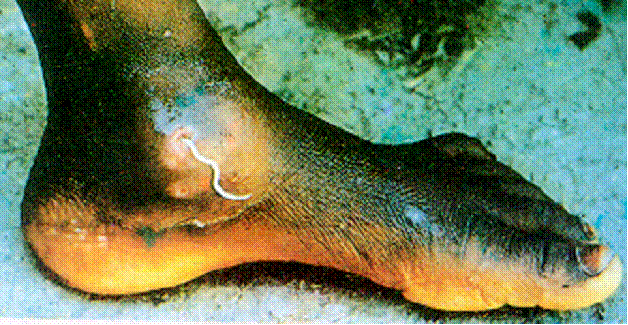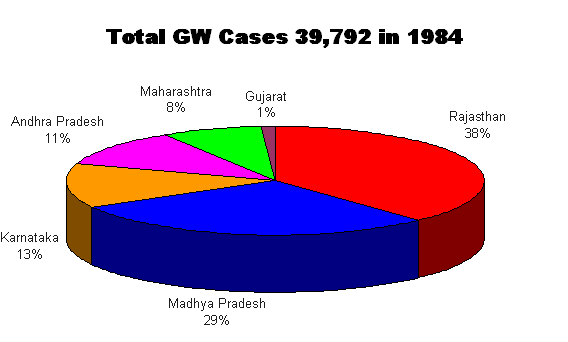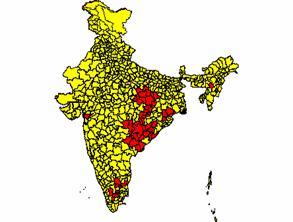Guinea Worm Eradication Programme (GWEP)
Certification of India as a Guinea Worm disease free country by the World Health Organisation in February 2000 is a
major milestone in the history of disease eradication in India. Guinea worm is the second communicable disease after
smallpox, which has been eradicated from the country, by the efforts of NICD and the concerned states.

Guinea Worm disease (Dracunculiasis) was an important public health problem in many states of India before it was
eradicated in 2000.
It is caused by a large nematode, Dracunculus medinensis, which passes its life cycle in two hosts – Man and
Cyclops.
Man harbours the adult parasites in the subcutaneous tissues, especially of legs, arms and back, which are likely to
come in contact with water.
A blister appears on the skin when the gravid 60-100 cm long adult female worm is ready to discharge its larvae. The
escape of larvae into the water takes place in batches and the parturition is usually complete in about 2-3 weeks.
These larvae are ingested by Cyclops and develop into infective stage in about 2 weeks. People swallow the infected
Cyclops in drinking water from step wells or ponds. The larvae are liberated in the stomach, cross the duodenal
wall, and enter the retro-peritoneal connective tissues where they grow and mature. The males die after mating. The
females migrate in about 6 months to parts which come in contact with water. Multiple and repeated infection may
occur in the same person. Diagnosis is made by visual recognition of adult worm protruding from a skin lesion or by
microscopic identification of larvae.
Cases occur in areas which have natural or artificial ponds or step-wells as sources of drinking water. Chances of
infection increase before the arrival of monsoon when the water level becomes low in ponds/wells. More cases occur
in adults, especially males due to increased frequency of exposure.
The prevention/control measures include making drinking water safe, not allowing villagers, especially those with
blisters and ulcers, to enter any source of drinking water, filtering water in endemic areas through fine mesh (size
100 micrometers) to remove Cyclops, converting step wells to draw wells, controlling of Cyclops by use of temephos,
and increasing awareness among endemic communities about the disease and its control.
Global Scenario
Although widely distributed in many countries in Asia, Africa, South America at the beginning of the 20th Century,
active foci are now found only in Africa. The World Health Assembly adopted Resolution WHA 44.5 in May 1991 to
eradicate dracunculiasis by 1995. As of date, a total of 180 countries and their territories have been certified by
WHO as having eliminated dracunculiasis. In addition, 8 countries are presently in pre-certification stage of the
elimination process. The disease continues to remain endemic in 6 countries in 2009 (Ethiopia, Ghana, Mali, Niger,
Nigeria, and Sudan). Overall, the annual incidence of guinea worm disease has declined from 892055 cases reported in
1989 to 4619 in 2008.
Guinea-worm Eradication in India
Encouraged with the success of “Small-pox Eradication”, the Ministry of Health & Family Welfare, Government of
India launched the National Guinea Worm Eradication Programme (GWEP) in 1983-84 as a centrally sponsored scheme on a
50:50 sharing basis between Centre and States with the objective of eradicating guinea worm disease from the
country. The National Institute of Communicable Diseases (NICD), Delhi was designated as the nodal agency for
planning, co-ordination, guidance and evaluation of GWEP in the country. The Programme was implemented by the
endemic State Health Directorates through the Primary Health Care system. The Ministry of Rural Development, Govt.
of India, State Public Health Engineering Departments, and the Rajiv Gandhi National Drinking Water Mission (Rural
Water Supply) assisted the Programme in provision and maintenance of safe drinking water supplies and conversion of
unsafe drinking water sources, on priority, in the guinea worm affected areas.
Strategy
Based on the life cycle of the worm and well defined prevention and control measures, Guinea Worm Eradication
Programme envisaged the efficient implementation of strategies including:
- Guinea worm case detection and continuous surveillance through three active case search operations and
regular monthly reporting - GW case management
- Vector control by the application of Temephos (50% EC) in unsafe water sources eight times a year and use of
fine nylon mesh/double layered cloth strainers by the community to filter cyclops in all the affected
villages - Provision and maintenance of safe drinking water supply on priority in GW endemic villages
- Trained manpower development and
- Intensive health education
- Concurrent evaluation and operational research.
NICD with financial support from the World Health Organization deployed epidemiological surveillance teams in
endemic states which closely monitored the Programme and helped the district/local authorities in effective
implementation of various GWEP operational components; especially surveillance and GW case containment measures.
How the disease declined?
At the beginning of the Programme i.e. in 1984, there were around 39792 GW cases in 12,840 villages of 89 districts
in seven endemic States (Table #).
Table 1, Guinea Worm Morbidity in India, 1984
| GW Endemic States | Districts | PHC | Villages | Population | Cases |
|---|---|---|---|---|---|
| A. P. | 6 | 54 | 1160 | 1566218 | 4461 |
| Gujarat | 13 | 56 | 444 | 1058012 | 1058012 |
| Karnataka | 8 | 73 | 991 | 1666123 | 5239 |
| M. P. | 21 | 131 | 3647 | 2723934 | 11341 |
| Maharashtra | 15 | 99 | 1213 | 1058452 | 3115 |
| Rajasthan | 23 | 146 | 5376 | 4849340 | 15210 |
| Tamil Nadu | 3 | 5 | 9 | 10048 | Nil |
| TOTAL | 89 | 564 | 12840 | 12932127 | 39792 |

Almost two-thirds of the total cases occurred in Rajasthan (38%) and Madhya Pradesh (29%). Karnataka (13%), Andhra
Pradesh (11%), Maharashtra (8%) and Gujarat (1%) accounted for the remaining cases.
The cases and the number of affected villages declined over a period of time. State-wise declining trends are shown
in Tables.
Table #, Trend of GW cases in India, 1984-1997
| Year | Rajasthan | Madhya Pradesh | Karnataka | Andhra Pradesh | Maharashtra | Tamil Nadu | Gujarat | Total |
|---|---|---|---|---|---|---|---|---|
| 1984 | 15210 | 11341 | 5239 | 4461 | 3115 | 0 | 426 | 39792 |
| 1985 | 11644 | 8349 | 4036 | 2389 | 4211 | 0 | 322 | 30950 |
| 1986 | 10500 | 4217 | 2754 | 1772 | 3646 | 0 | 181 | 23070 |
| 1987 | 7896 | 3282 | 2405 | 1122 | 2156 | 0 | 164 | 17031 |
| 1988 | 5619 | 2565 | 1909 | 407 | 1496 | 0 | 27 | 12023 |
| 1989 | 4872 | 1408 | 896 | 224 | 475 | 0 | 6 | 7881 |
| 1990 | 3376 | 333 | 634 | 224 | 209 | 0 | 22 | 4798 |
| 1991 | 1712 | 120 | 226 | 126 | 0 | 1 | 0 | 2185 |
| 1992 | 792 | 91 | 167 | 30 | 1 | 0 | 1081 | |
| 1993 | 547 | 179 | 29 | 0 | 0 | 755 | ||
| 1994 | 348 | 13 | 10 | 371 | ||||
| 1995 | 60 | 0 | 0 | 60 | ||||
| 1996 | 9 | 9 | ||||||
| 1997 | 0 | 0 |
Note: Last cases in the country occurred in Rajasthan in 1996.
Table #, GW affected villages in India, 1984-1999
| Year | Rajasthan | Madhya Pradesh | Karnataka | Andhra Pradesh | Gujarat | Maharashtra | Tamil Nadu | Total |
|---|---|---|---|---|---|---|---|---|
| 1984 | 5376 | 3647 | 991 | 1160 | 444 | 1213 | 9 | 12840 |
| 1985 | 3394 | 2855 | 715 | 741 | 204 | 902 | 0 | 8811 |
| 1986 | 3276 | 1575 | 662 | 599 | 140 | 853 | 7105 | |
| 1987 | 2755 | 1170 | 398 | 414 | 130 | 767 | 5634 | |
| 1988 | 2258 | 867 | 356 | 241 | 81 | 475 | 4278 | |
| 1989 | 2009 | 825 | 271 | 150 | 52 | 289 | 3596 | |
| 1990 | 1565 | 485 | 249 | 88 | 15 | 190 | 2592 | |
| 1991 | 1310 | 292 | 159 | 69 | 5 | 71 | 1906 | |
| 1992 | 957 | 98 | 104 | 55 | 4 | 26 | 1244 |
Table #, GW affected villages in India, 1984-1999
Once the state remained disease free for 3 years consecutively, it was deleted from the list of endemic states. Gujarat was deleted from the list of endemic states on 31 December 1993. Andhra Pradesh and Maharashtra were deleted on 31 December 1995, while Karnataka and MP were deleted from the list on 31 December 1997. The last cases occurred in July 1996 when 9 guinea worm cases were recorded in three villages from district Jodhpur (Rajasthan) which were adequately contained. Thus Rajasthan State was deleted from the list of endemic states on 31 December 1999.
During April 1999, Seventh Independent Evaluation of GWEP was conducted by independent experts; twenty teams were sent to seven erstwhile endemic states and fourteen non-endemic states/UTs. The results validated the zero guinea worm status in India.
Last case of Guinea worm in India
- 6 July 1996
- Mr Bhanwara Ram, 25 years
- Village: Aau, PHC: Peelwa
- District: Jodhpur, Rajasthan
- Father had guineaworm in 1995
- Brother and sister had guineaworm in 1996
Towards Certification of Eradication
- A National Commission for Certification of Guinea Worm Eradication was set up by the Ministry of Health and Family Welfare. The Commission comprised of eight highly experienced independent experts in the field of Public Health drawn from across the country and the Director and Joint Director and Head of Helminthology Division of the National Institute of Communicable Diseases. The Seventh Independent Evaluation was carried out under the guidance of the Commission in April 1999.
- The country completed three years of guinea worm disease free period in July 1999. Subsequently, International Certification Team (ICT) from International Commission for Certification of Dracunculiasis Eradication (ICCDE), WHO visited India from 9th -25th Nov., 1999 to assess the status of guinea worm disease in the country and to prepare a report for presentation to International Commission at Geneva.
- A meeting was organised on 8.1.2000 in Vigyan Bhawan to mark the Eradication of Guinea Worm Disease from India which was presided by Hon’ble Union Minister of State for H&FW, GOI Shri N. T.Shanmugam and Dr. Gro Harlem Brundtland, Director General, World Health Organisation, Geneva was the Chief Guest.
- The International Certification Team, presented its report on guinea worm disease status in India to the ICCDE in the meeting held in February 2000 in Geneva. On the basis of ICT report, India was declared as Guinea Worm disease free country in this meeting.
Keeping in view that the global eradication of guinea worm disease has not been achieved, the States are continuing the routine surveillance for the disease (till global eradication is achieved).
- 1An epidemiological investigation was carried out on a Guinea Worm rumour in a person from Meerut city, Meerut. Uttar Pradesh. The information regarding the rumour was initially received through Dr. R. K. Mahajan, Sr. Microbiologist, RML Hospital, New Delhi.
The team visited the concerned person at his resident on 13.10.2008. On the basis of Epidemiological investigations, morphological appearance, body tissue composition of the worm/orientation, the parasite was identified as Plerocercoid (spargana).
- 1Surveillance activities are being carried out in 7 states (Andhra Pradesh, Gujarat, Karnataka, Madhya Pradesh, Maharashtra, Rajasthan and Tamil Nadu) and 89 districts endemic for guinea worm disease erstwhile. No guinea worm case was reported during 2008-09

Fig # : Funnel net: Device for sampling Cyclops density










